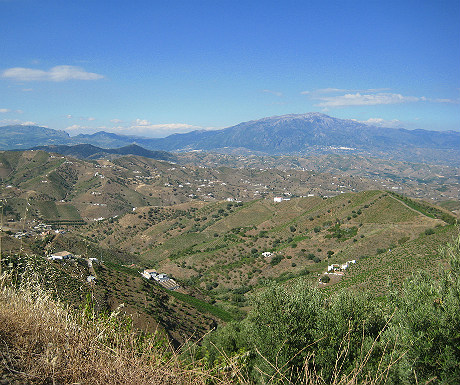The culinary map is, shall we say, peppered with well known and well tread “must see” destinations: cities such as Paris, New York, London, Bangkok and Sydney to name but a few, and more rural or regional destinations such as Provence, Basque Country, Napa Valley and Tuscany. But there’s one rising star on the Spanish gastro-map that you’ve possibly never heard of… yet.

On Andalucia’s Mediterranean coast, just at the border between Malaga and Granada Provinces, lies the mountainous little region of La Axarquia. This historic spot began mass agricultural production with the Phoenicians some 3000 years ago and has been a major producer of olives, olive oil, grapes and wine ever since. With the fertile Velez River valley draining off all of the surrounding mountains, the region is now more than ever a powerhouse producer of almonds and avocados, and tropical fruit such as mango and papaya in addition to olives, oil and grapes. A new trade deal allowing avocados from the region into the U.S. market is sure to spur business further.
Yet beyond simple agricultural production, the area has added some finesse to its centuries old culinary traditions. Two of the finest wineries in Andalucia call La Axarquia home: Ordoez and Bodegas Bentomiz, both with international award winning wines. A third Axarquian winery makes the claim of smallest winery in Spain, Sedella Vinos, producing the region’s only red wine made with grapes actually grown in La Axarquia. And with a Moorish legacy more than a thousand years old, many traditional dishes have developed a new life. Cold almond and garlic soup may not sound so appetizing, but “ajo blanco” can be a delight when done with flair, as can “salmorejo”, a thick emulsion of cold tomato soup.
Some of the region’s best chefs will use these not as dishes on their own, but as accompaniments, such as a delicate fish tartar in a sauce of ajo blanco served by Chef Juan Quintanilla in Nerja, the Axarquian coastal village boasting the best restaurants between Malaga and Almeria. Axarquian born chef Jose Carlos Garcia uses gellyfied spheres of a traditional fish soup to accompany a succulent cod at his Michelin starred restaurant JCG. It’s no surprise that the local chefs are getting creative with the seafood either, the Axarquian village Caleta de Velez is the busiest, most important fishing port in Malaga Province.
It’s true that many of the tiny mountain pueblos of La Axarquia present a hearty and rustic sort of traditional fare, but some of them have developed simple techniques into an art for which they can hardly contain their pride. In Canillas de Aceituno, for example, a long history of the finest roast kid has developed into a widely renowned reputation. With all of the upscale restaurants of the Marbella area, Spaniards will still make the hour and a half journey into the hills of La Axarquia to sample the famous oven roasted baby goat served up in quantity at La Sociedad in Canillas de Aceituno daily. Thanks to one enterprising young “Canillero”, you can now purchase the famed “chivo de Canillas” pre-roasted and packaged by the local company of the same name in gourmet shops all over Spain and beyond.
Each of the villages of La Axarquia will have at least one gastronomic festival each year where they turn through tons of their particular specialty, from black pudding or sardines to goat’s cheese or the simple goodness of fresh cherries or roasted chestnuts. Gastronomy has been an integral part of the Axarquian life for centuries, even if the unassuming people themselves wouldn’t think twice about it. But if you haven’t heard of La Axarquia before now, keep your ears open and your taste buds ready – you may well do soon.